Taking care of a new goldfish is pretty easy. While keeping one may be somewhat tricky, a little research and effort can help you maintain a healthy and happy goldfish.
Truthfully, even a newbie in fishkeeping will not have a lot of problems in taking care of them.
Finding a perfect and suitable aquarium mate, however, is a different story. Just because they are resilient and charming, it does not mean you just can put any kind of fish into their aquarium.
Otherwise, you might be putting the well-being and life of your goldfish at risk. Adding some betta fish, for instance, is a horrible idea.
Not only are betta fish aggressive, but these warm-water creatures also have different living conditions and temperaments.
That is why it is vital to find a tank mate for your pet that has a mild temperament and prefers the same aquarium conditions.
Furthermore, you need to find a fish that meets the other crucial requirements to ensure the safety and health of everybody in the tank.
Here are some tips that will help you find the best tank mates for your goldfish.
What Makes a Suitable Tank Mate for Goldfish?
It can be a little challenging to find the best aquarium mates for your beloved goldfish. So, take a look at these significant factors that you need to put into consideration in your search for the best aquarium mates for your goldfish.
Size
Fish are simplistic thinkers. When they explore the tank and see other smaller fish, they will think it is a snack.
Goldfish are essentially voracious eating machines with an insatiable appetite. They will literally vacuum up and consume anything edible that can fit into their mouths.
And, that also includes your pet’s smaller aquarium mates, even if they have been together for a while.
So, look for tank mates that are around 3 to 4 inches in length.
Swimming Speed
Although risky, it is still possible to have smaller fish in a goldfish’s aquarium. Just make sure that the fish is quick, fast and can conveniently outswim any hungry goldfish.
Also, your gallon should be large, like a 40-gallon tank, to give the smaller fish plenty of room to escape the marauding goldfish inside the tank.
Range of Temperature
Goldfish are, for the most part, classified by experts as cold-water fish. Even though it is technically an incorrect term, it is what most hobbyists call the temperate fish that lives at temperatures ranging from 18° to 24°C (65° to 75°F).
Most aquarium fish originate from tropical regions and prefer to swim in temperatures around 24° to 27°C (75° and 80°F).
Keeping these fish in water temperatures under 24°C might cause stress, and ultimately kill them.
Angelfish, gouramis, and bettas, for instance, have to be in water temperatures close to 80°F. If you want to combine these creatures with your goldfish, you have to keep your goldie in a temperature that is too warm for your pet.
Or, you may set a water temperature that is too cold for the other fish.
Both are not long-term solutions and may cause one of the fish species to get sick or die.
So, find a fish type that will survive in the same range of temperature as your pet goldfish.
Level of Aggression
Despite their tendency to eat smaller fish, goldfish are often deemed as peaceful creatures.
Unlike other fish, goldfish do not swim around acting aggressively and nipping the fins of other fish.
In fact, these creatures cannot do anything if other fish bullies them. Even worse, they have long trailing fins that make them a target for fin-snipping fish species, like most tetra fish and tiger barbs.
So, you should look for fish that are pretty peaceful. Trust me, you do not want your goldfish to get stressed or be beaten up by bullies.
What Fish can Live With Goldfish?
It is time for the fun part! Check out this list of finned pets that make terrific aquarium mates for goldfish.
White Cloud Mountain Minnow
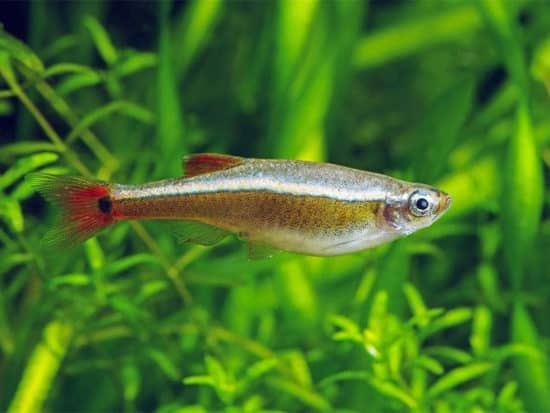
White cloud mountain minnows are a goldfish owner’s dream. They are peaceful, inexpensive, beautiful, and pretty easy to take care of. And, best of all, they make a terrific aquarium buddy for your goldfish.
Like goldfish, they are also cold-water fish and peace-loving. Even better, they do not like to compete for food.
As a matter of fact, they prefer to wait for food leftovers instead of fighting with the other fish to get them. And, that means your goldfish will never be underfed, with the white cloud mountain minnows as their tank mates.
Other important information:
- Minimum aquarium size: 10 gallons
- pH level: 6.0 to 8.0
- Aquarium water temperature: 64 to 79 °F
- Temperament: Sociable and peaceful
- Maximum size: 1.5 inches
Other Goldfish Breeds
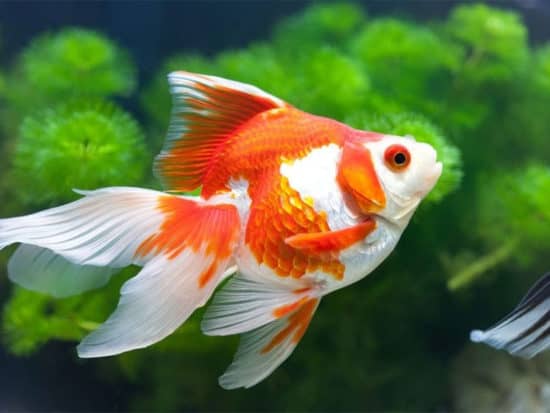
There are a lot of different goldfish breed types, including celestial eye, telescope eye, ranchu, ryukin, shubunkin, comet, and the common goldfish.
Although they usually do not have issues getting along with their kind, putting different goldfish breeds in one tank is not exactly a bright idea.
So, look for goldfish breeds that make an excellent fit for one another.
For example, slim-bodied goldfish, like shubunkin, comet, and common goldfish, are well-known for their strength and speed. And, if you put them in an aquarium with slow eaters and swimmers like fantail and lionhead, it would be a disaster for the latter groups.
Fancy fish will definitely struggle to compete for food against the strong and fast breeds. And, eventually, the slower fancy breed will suffer from stress and malnutrition when paired with slim-bodied goldfish.
Another point worth noting is that larger species are practically predators and will likely swallow the smaller breeds of goldfish.
So, avoid mixing small and large goldfish in one tank, as much as possible.
Other important information:
- Minimum aquarium size: 15 gallons
- pH level: 6.0 to 8.0
- Aquarium water temperature: 65 to 72 °F
- Temperament: Peaceful
- Maximum size: 4 inches
Dojo Loach
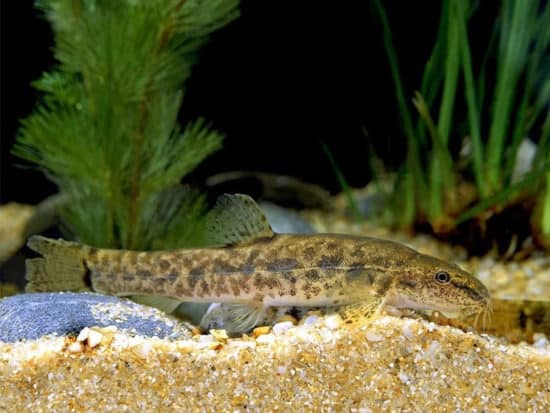
Dojo Loaches are fascinating bottom readers that make a terrific tank mate for your goldfish. They are peaceful, and they keep the aquarium substrate clean by eating any uneaten food that hits bottom using their face whiskers.
You, however, need to make some changes to your aquarium if you want to pair it with your goldfish. For one, it requires a strict maintenance schedule and heavy filtration because they, together with goldfish, produce a great deal of bioload.
Additionally, you need a bigger tank since they can quickly grow around 30 centimeters in length.
Other important information:
- Minimum aquarium size: 75 gallons
- pH level: 6.0 to 8.0
- Aquarium water temperature: 65 to 75 °F
- Temperament: Peaceful
- Maximum size: 12 inches
Rosy Barbs
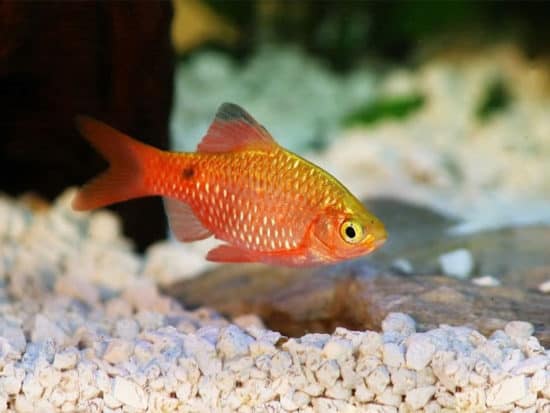
No list of the best aquarium mates for goldfish is complete without the inclusion of Rosy Barbs. Known for their torpedo shape, vibrant colors, and laid-back temperament, rosy barbs are the perfect community fish mate.
As long as their social needs are appeased, they usually will leave the goldfish alone and just mind their own business. They certainly have no issues getting along with your goldfish.
Since they are a schooling fish, you need a few rosy barbs in your aquarium for it to thrive and survive.
My advice is to have around 5 of these fish in your aquarium, along with your goldfish.
Other important information:
- Minimum aquarium size: 30 gallons
- pH level: 6.5
- Aquarium water temperature: 64 to 72 °F
- Temperament: Peaceful
- Maximum size: 6 inches
Zebra Danios
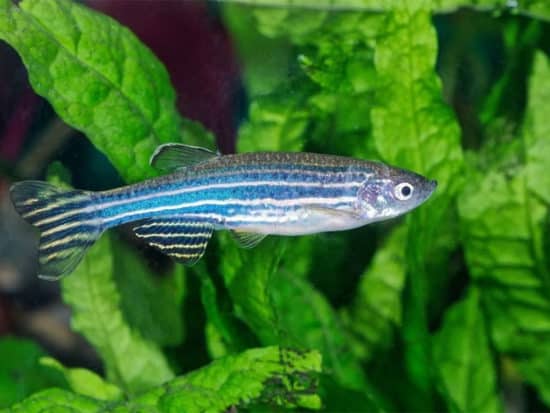
Zebra Danios are tiny, wondrous, and speedy fish that can, with ease, tolerate the goldfish’s temperature range.
With an average length of 2 inches, these fish are small enough for an adult goldfish to consume them.
But, they are incredibly fast, and so much quicker than most goldfish.
It is a bit risky to combine these two fish species, but danios can easily outswim the goldies.
Also, try to put some artificial aquarium plants to give them places to hide if they need it.
Other important information:
- Minimum aquarium size: 10 gallons
- pH level: 6.5
- Aquarium water temperature: 65 to 75 °F
- Temperament: Peaceful
- Maximum size: 2 inches
Platy
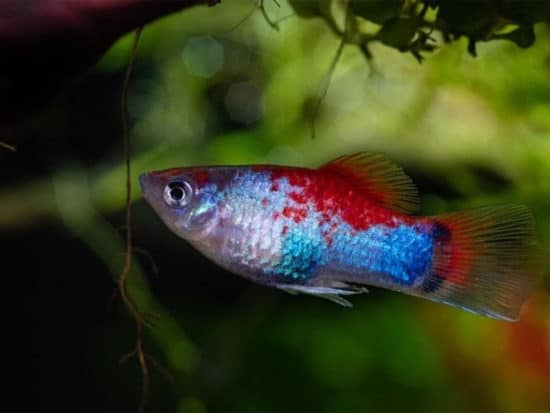
Platies are mostly viewed as a tropical fish. Even so, they can thrive along with your goldfish in the lower 70s.
For a tiny fish, they are amazingly thick-bodied and come in a wide array of colors and patterns. Speaking of size, juvenile platy may seem a tempting treat for your goldfish, but it moves so fast and can outswim most goldfish species.
Platies, however, are voracious eaters and fast swimmers, meaning you should ensure that goldfish are getting enough food.
Other important information:
- Minimum aquarium size: 10 gallons
- pH level: 6.8 to 8.0
- Aquarium water temperature: 70 to 80 °F
- Temperament: Peaceful
- Maximum size: 2.5 inches
Bristlenose Pleco
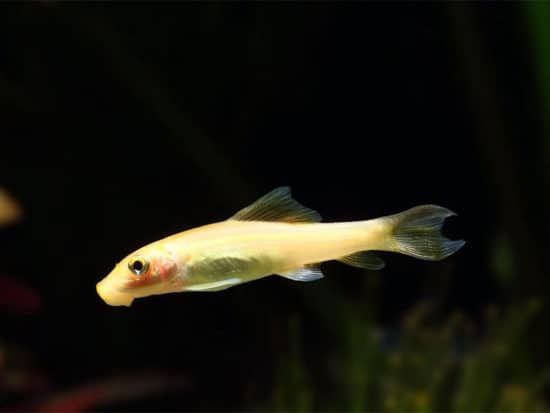
The bristlenose pleco is a peaceful and calm catfish that originates in the rapid-flowing Amazon River Basin waters. With their sociable and laid-back temperament, this catfish definitely makes one of the best aquarium companions for goldfish.
Moreover, they will make your aquarium so much cleaner and even reduce your fish tank maintenance requirements. Take note that these fish are herbivores that spend a ton of time foraging through the tank for dead organic materials and algae.
You still, however, should feed them a couple of times per day with granules, bloodworms, spirulina wafers, or more algae to make sure that they get all their nutritional needs.
One of the things that I surely love about it is that it does not have any problem adapting to different aquarium conditions.
Other important information:
- Minimum aquarium size: 40 gallons
- pH level: 5.8 to 7.8
- Aquarium water temperature: 73 to 81 °F
- Temperament: Sociable and peaceful
- Maximum size: 5 inches
Giant Danios
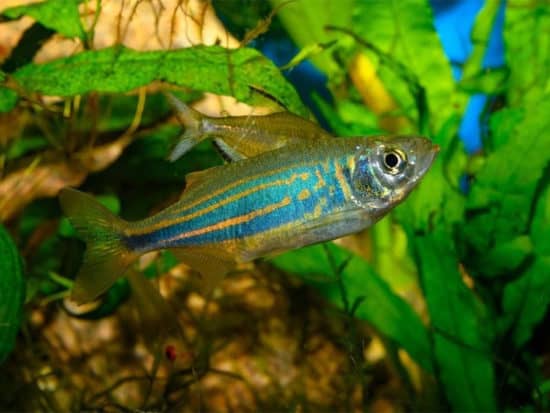
Giant danios, with their iridescent yellow and blue stripes, look quite a lot like their cousins, the zebras. But, these danios are almost twice as big as the zebra varieties.
Additionally, they are practically a schooling fish, meaning you need to keep them in a group of around 5 or even more.
If their gang is rather small, these fish tend to become more aggressive or stressed. Also, you should put a few artificial decorations and plants in your aquarium. That way, they will have some helpful hiding spots if they ever need it.
Since these fish are faster than goldfish, when it comes to swimming, you need to be sure that the danions will not outcompete your goldies for food.
Other important information:
- Minimum aquarium size: 30 gallons
- Water pH level: 6 to 8
- Aquarium water temperature: 70 to 75 °F
- Temperament: Sociable and peaceful
- Maximum size: 5 inches
Weather Loach
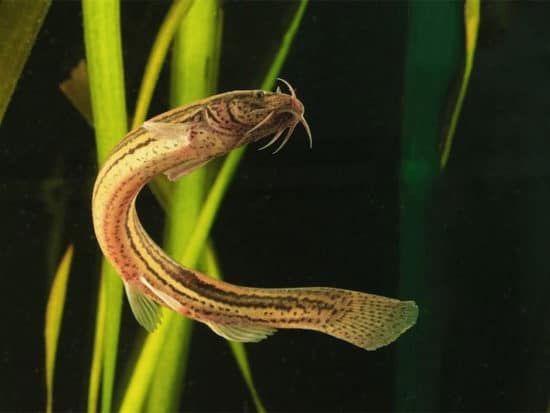
Weather loaches are meteorologically blessed creatures used by scientists to predict changes in weather and even upcoming natural disasters.
And, it is a cold-water fish species, meaning it has no problems adjusting to the living conditions of the goldfish.
Plus, it is peaceful and is easy to maintain. As with other social pet fish, these loaches prefer to live in a group, so you should have at least three of them in your aquarium.
They have long elongated bodies that may grow up to 12 inches, meaning it is crucial to get a larger aquarium.
Other important information:
- Minimum aquarium size: 20 gallons
- pH level: 6 to 8
- Aquarium water temperature: 40 to 77 °F
- Temperament: Sociable and peaceful
- Maximum size: 12 inches
Fish That Can not Live With Your Goldfish
Maintain a healthy and friendly environment for your goldfish by steering clear of these aquatic creatures.
- Cichlids: They are aggressive and hostile predators that do not blend well with goldfish. While goldfish are somewhat predators, they are generally peaceful and harmless creatures.
- Common plecos: Bristlenose and rubbernose plecos do well with any goldfish. The common plecos, however, can be a headache since they suck off your goldfish’s slime coat.
- Bettas: Not only do they prefer a warmer aquatic environment, but they are also aggressive creatures that may nip the fins or attack your goldfish.
- Corydoras: They are pretty aggressive, and they will suck your pet’s slime coating.
- Mollies: These tropical fish prefer warmer water conditions and are pretty aggressive, meaning they might attack your goldfish.
- Tetras: These fish cannot thrive on cooler water, and they will also have a difficult time living in one tank with the slightly messy goldfish.
Do you agree with us? Guess what? We would love to hear from you! Feel free to share your thoughts and opinions with us through the comment section.
